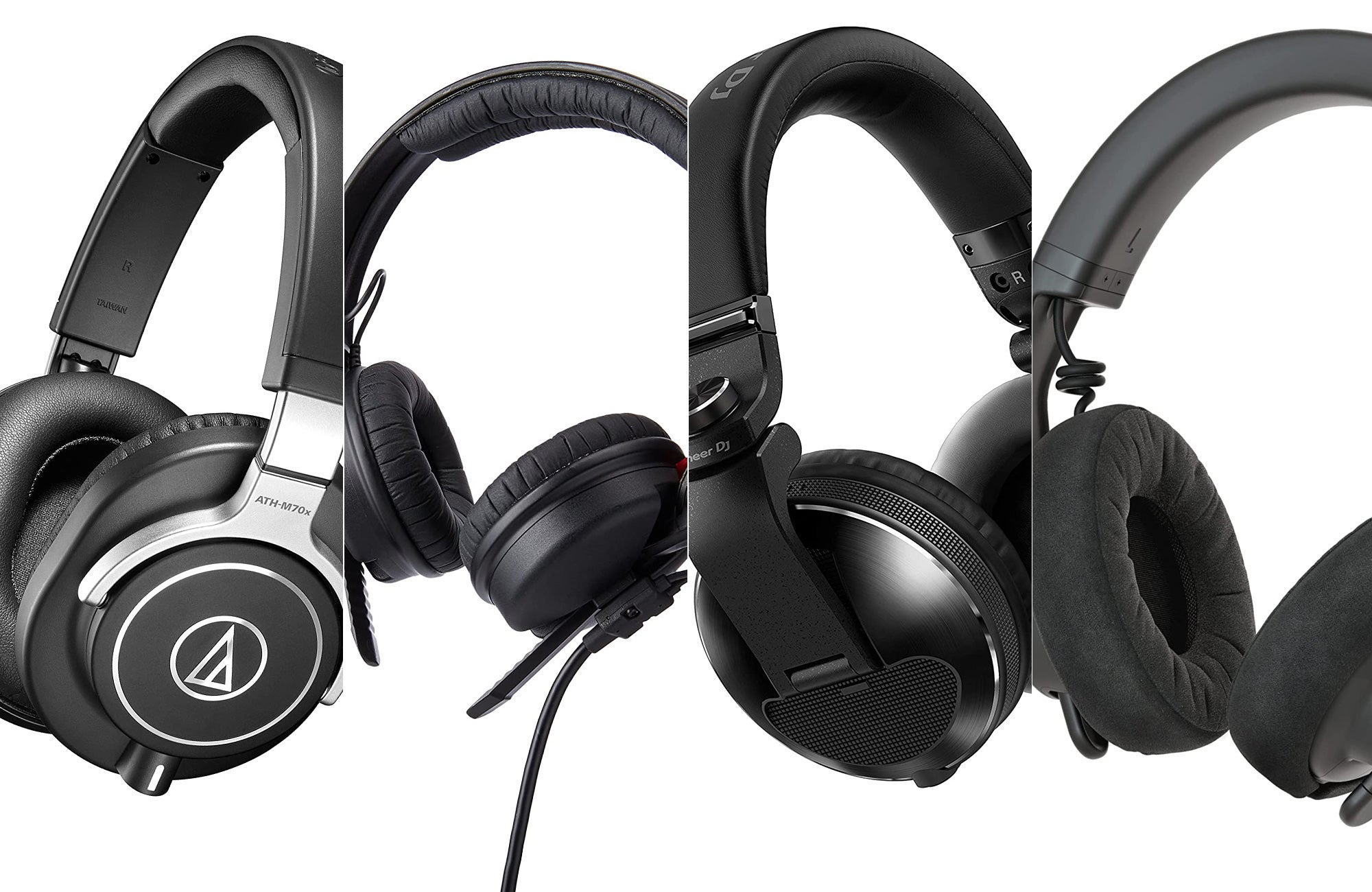Contents
Published Jul 8, 2022 1:00 PM
DJ headphones, at their core, don’t function much different from the best headphones meant for everyday listening or for music production. But beyond the basic concept of speakers pushing air, DJ headphones usually target their audience with a combination of isolating pads and high SPLs (sound pressure levels)—which is the maximum output volume—for blocking out and cutting through the din of crowded clubs with audible bass response. After all, that’s where you keep the beat. DJ headphones also feature build quality for constant putting on and taking off, and earcups that swivel or detach from the headband for one-ear monitoring. Some of them also cater to busy DJs who wear out headphones quickly by making some or all of the parts easily replaceable. And wireless DJ headphones that actually have low enough audio latency to function properly for DJs are also now available. Here’s our spin on the best DJ headphones.
How we selected the best DJ headphones
I have been a performing DJ for more than 15 years and have covered DJ gear for DJ Tech Tools, Electronic Musician, Remix, Popular Science, and other outlets. I’ve personally used four of the six headphones on this list for public DJ sets, livestreams, or extensive reviews, and the remaining choices are based on thorough research, the feedback of fellow DJs, other expert reviews, and trusted user impressions. This selection includes the best DJ headphones at a variety of price points for either dedicated DJ use, DJing plus music production, or DJing plus overall use.
Things to consider before buying the best DJ headphones
This list does not include any in-ear monitors. Although some DJs use in-ear monitors, that’s for a different style of working where the in-ears are usually kept in throughout the DJ’s set and they block out much or all of the sound from the venue. So the DJ is hearing the main mix through the in-ears at all times and also monitors the next track before the audience hears it. There’s nothing wrong with that style of DJing and it can be healthy on the ears if it blocks out overly loud club sound, allowing you to mix at lower decibels. However, DJing in a way where you’re not hearing any of the same main room sound as the crowd can make you feel a little disconnected. And in-ear DJ monitoring is still not all that common, so this guide covers only on-ear and over-ear full-size headphones.
Will you use them only for DJing?
Oftentimes DJs will have headphones they only use for DJing, while they use other headphones for mixing music, everyday listening, etc. That may be because they want to preserve their favorite DJ headphones for exclusive DJ use, or it may be because most DJ headphones are not meant to be the be-all-and-end-all of feature-laden headphones. Several key qualities of DJ headphones include a loud, accurate, but more energetic (some might call it V-shaped) sound for cutting through noisy surroundings like live venues with bass and treble. In addition, DJ headphones are more likely to have closed-back earcups with thicker foam pads for isolating sound and feature a way to monitor with one ear—usually earcups that either detach from the headband or swivel and rotate to create angles ideal for holding one cup to a single ear.
If those traits are the DJ headphone maker’s only focus, you may get something like the outstanding Pioneer DJ HDJ-X10. What you won’t get are other features that some people may want if they’re using headphones for more than just DJing: an inline mic/controller on the audio cable, wireless connectivity, and any other powered/microphone-focused/circuit-based features, like active noise cancellation or 3D/EQ sound modes.
Regarding open-back headphones: Many at-home listeners like them because they can create a sense of a larger, airier soundstage, as well as let the earcup “breathe” to avoid the build-up of perspiration moisture. However, open-back headphones let in more noise from external sounds, so they’re not ideal for monitoring DJ mixes and aren’t featured here.
Simplicity vs. complexity
You certainly can DJ with headphones that are a bit nontraditional. For example, the AIAIAI TMA-2 Studio Wireless+ in this guide finally make wireless headphones viable for DJing because they send an ultra-low-latency audio signal. And consumer-oriented headphones like the Yamaha YH-L700A headphones have a big sound and swiveling ear cups that could make them suitable for DJing if you wish. However, the question is how complicated to use do you want your DJ headphones to be and do you want them to include all kinds of expensive extra features that you don’t need for DJing?
In the case of the $499 YH-L700, it’s loaded with technology—like active noise canceling, Bluetooth 5.0, several 3D sound processing modes, and onboard playback controls. Those features require charging the built-in battery, drive up the price, and don’t really apply to DJing. Some people may want to try DJing with active noise canceling, but that technology does alter the sound coming from the headphones a little bit, which most DJs do not want to do. If you end up wearing out a pair of headphones like that while DJing or, worse, they get lost, damaged, or stolen while DJing, you would have spent a lot of money on features that you probably didn’t use to their fullest.
On the other hand, the AIAIAI TMA-2 is very appropriate for DJing. Its liberating low-latency wireless technology lets you move about the DJ booth or studio without having to worry about getting the headphone cable caught on something or accidentally pulling it out. But just think about whether or not you want your DJ headphones to require a separate wireless transmitter unit that you have to remember to keep charged along with charging the headband battery as well.
While the Yamaha, AIAIAI, and most other high-tech headphones that have battery-powered features also operate as wired headphones without battery power, all their extra electronics create additional fail points and complicate their maintenance in ways that simpler wired DJ headphones do not.
Price
If you’re the type of DJ who buys a new sports car after wrecking your last sports car, go ahead and buy two or three of everything on this list. Otherwise, the bottom line usually plays a role in any gear-buying decision. Audiophile and professional studio-grade reference headphones can cost well over $1,000, which makes the sub-$400 Pioneer DJ HDJ-X10 headphones look like a real bargain. However, that’s still considerable money. For the most part, you get something in return for what you pay for DJ headphones, whether it’s in build quality, sound quality, comfort, or some combination of everything. Sometimes name recognition and reputation may play a small part in the price as well.
When you take DJing seriously, it’s worth it to pay for headphones that have the sound and features you want, so that your headphones don’t frustrate you or distract you in any way from the job at hand. But you can also get by quite well on low-priced headphones, whether they are your only pair, or you want a “burner” set as a backup or as something that won’t devastate you if it breaks, gets lost, or stolen.
The best DJ headphones: Reviews & Recommendations
While it may not be as good as DJing itself, choosing DJ gear is part of the fun. There’s something extra satisfying about picking out a piece of tech that will serve a creative and productive purpose, rather than just another toy for your amusement (although DJ headphones are that, too). So let’s get down to the good part and examine the best DJ headphones available right now.
Best overall: Pioneer DJ HDJ-X10
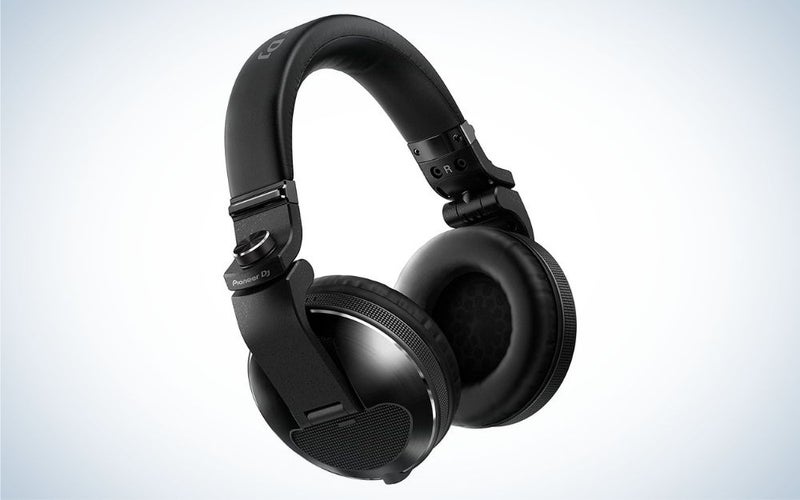
Why it made the cut: The flagship headphone from the biggest DJ gear company comes through with rugged durability, big full-spectrum sound, and lasting comfort.
Specs
- Weight: 0.72 pounds (without cable)
- Driver Units: 50mm dome type high-definition drivers
- Frequency Response: 5Hz-40kHz
- Accessories: 48-inch coiled cable (extends to 118 inches), 63-inch straight cable, 1/4-inch stereo plug adapter (threaded), zippered hardshell case with handle
Pros
- Powerful yet clear and balanced high-resolution sound
- Reliably robust build for professional use
- Comfortable materials and fit
Cons
- Comparatively high price
- Non-standard detachable cable connectors
If you had to boil down what’s important in DJ headphones to one word, it may be “dependability.” As one of the key elements to a live performance where mistakes can be catastrophic to your confidence and/or reputation, DJ headphones have to be dependable in the areas of sound reproduction and power, as well as physically dependable to take abuse yet not to dish it out to your head and ears. Perhaps that’s why the HDJ-X10—the top-of-the-line headphone from Pioneer DJ, the company that supplies clubs and consumers with mixers, monitors, and other DJ booth mainstays—does nothing it doesn’t need to do and does everything it does very, very well.
First of all, its audio is not the loudest of all DJ headphones, but it’s loud enough at a 106 dB sound level, and its over-ear, closed-back design does a good job at isolating the headphone mix from outside noise. The high-resolution sound from the newly developed 50mm drivers delivers an extended frequency response and a very clear sound throughout the frequency range. The bass is very pronounced but not overly hyped or overpowering of midrange elements.
Physically, Pioneer DJ built the HDJ-X10 meticulously for heavy DJ use. The moving parts—like the joints for swiveling the ears cups 90 degrees sideways and rotating them backward 180 degrees—are of trusty metal construction. The headband is also strong yet flexible. The headband and replaceable ear pads are covered in durable, cleanable polyurethane. While everyone’s head and ears are different shapes and sizes, so that no headphones can ever please 100% of DJs, the HDJ-X10 fits comfortably enough on me for all-day use. Finally, the audio cable is an L-type locking mini-jack, so while it’s a little harder to find a replacement cable if you need one, you’re also protected from the potentially panic-inducing event of the audio cable disconnecting in the middle of a live set.
Best Bluetooth: AIAIAI TMA-2 Studio Wireless+
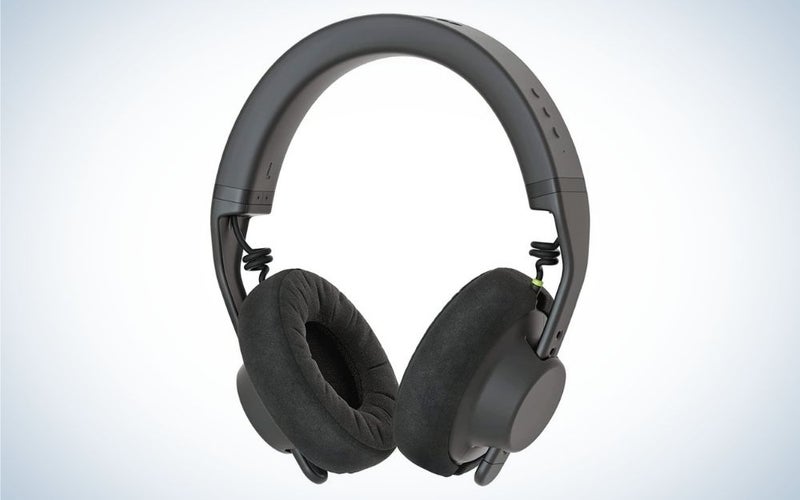
Why it made the cut: AIAIAI has made DJing with wireless headphones tenable by creating a set using the low-latency W+ Link wireless format and its own wireless transmitter.
Specs
- Weight: 0.5 pounds (headphones only)
- Driver Units: 40mm “bio-diaphragm” speakers
- Frequency Response: 20Hz-20kHz
- Accessories: Wireless transmitter with both Bluetooth 5.0 and W+ Link ultra-low latency wireless, USB-C charging cable, 60-inch coiled cable (extends to 126 inches), 1/4-inch stereo plug adapter (threaded), carrying pouch
Pros
- Low 16ms latency time suitable for DJ performances
- Modular parts for replaceability
- Light and compact enough for portability
- Includes both uncompressed wireless audio and Bluetooth compressed audio for longer battery life
Cons
- Output level is more consistent with studio headphones than DJ headphones
For both DJing and music production, wireless headphones up to now have been riddled with too many caveats to make them worth consideration: lossy transmissions, burdensome wireless transmitters, signal interference, and, worst of all, latency between the audio source and the headphone output. In-ear monitors operating on dedicated channels are proven for live performances, but typically out of the price range and off the technical rider of most working DJs. By taking in the top concerns of working DJs and musicians, AIAIAI has made the TMA-2 Studio Wireless+ headphones the first wireless headphones I could recommend for DJing. First and foremost, it uses a compact X01 transmitter to send ultra-low-latency (16ms) uncompressed audio (up to 16-bit/44.1kHz) using the W+ Link codec. That’s low enough latency to not notice the lag between manipulating your DJ gear and the audio in your cans, since human brains start to notice audio latency at around 20-30ms. In comparison, traditional Bluetooth has a latency of about 100ms, which will drive you crazy if you try to DJ with that lag. Bluetooth 5.0 with the Qualcomm aptX codec is much better at 40ms, but still not fast enough to recommend for performance.
However, the TMA-2 Studio Wireless+ also includes Bluetooth 5.0 for longer battery life for casual listening, like when previewing possible tracks or setting cue points for tomorrow’s gig. Both the X01 transmitter and the H10 headband (which receives the wireless signal) are battery-powered and recharge over USB-C. Battery life for uncompressed W+ Link playback is advertised at 16 hours, while Bluetooth playback gets you 80 hours of battery life. A three-button array on the H10 headband controls play/pause/next and volume during Bluetooth playback, or just the volume during W+ Link playback. Wired operation is also possible to bypass battery power.
AIAIAI also builds the TMA-2 Studio Wireless+ with a modern aesthetic, both in terms of its minimalist looks and its sustainable aims. For instance, the headphones’ parts are modular, so you can replace the headband, ear pads, and driver units separately, and the over-ear memory foam ear pads are covered with CO2-neutral Alcantara material.
While the TMA-2 Studio Wireless+ are fast enough in their latency for DJing, comfortable enough to wear for long DJ sets, and have detachable ear cups for one-ear monitoring, they still were made primarily for musicians in a music studio. They have, for example, a volume level normal for studio headphones but a little lower than what DJs often like for live monitoring. Word has it that AIAIAI is working on wireless headphones dedicated to DJs, including increased volume and other DJ-centric features.
Best for mixing music: Audio-Technica ATH-M70x
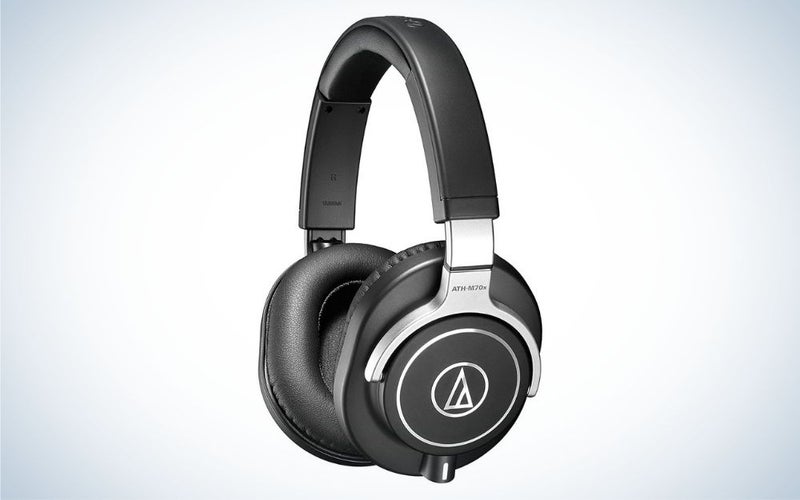
Why it made the cut: Audio-Technica is well-known for studio-grade sound at reasonable prices and the ATH-M70 combines the needs of DJs and music producers.
Specs
- Weight: 0.62 pounds (without cable)
- Driver Units: 45 mm neodymium magnet drivers
- Frequency Response: 5Hz-40kHz
- Accessories: 48-inch coiled cable (extends to 118 inches), 48-inch straight cable, 118-inch straight cable, 1/4-inch plug adapter (threaded), zippered hardshell case with cable pouch
Pros
- Flat, accurate, and clear audio across the audio range
- Extended frequency response
- Three detachable audio cables included
Cons
- Built more for studio use than touring/live shows, in terms of output level and durability
Making your own music ranks as one of the best ways to stand out and promote yourself as a DJ. And it’s just a fun thing to do, as DJs are music lovers first and foremost. So when you need a set of DJ headphones that also double as your reference headphones for mixing and mastering music, the Audio-Technica ATH-M70x closed-back monitoring headphones fit the bill. They have an extended frequency range and a flat response across the audio spectrum so that you can hear every element of a mix evenly. Audio-Technica headphones, in general, are known for reliable audio quality at reasonable prices and the ATH-M70x delivers excellent clarity and stereo imaging. The over-ear, closed-back design isolates the audio with minimal bleed from outside noise.
The ATH-M70x’s ear cups have metal yokes and swivel 90 degrees for one-ear monitoring, and its ear pads and headband padding are replaceable. If you’re looking for similar performance in a DJ headphone set that’s also appropriate for music production but for more than $100 less, the very popular Audio-Technica ATH-M50x—one of our perpetual favorite monitoring headphones—makes for a great choice. The rest of the line doesn’t have the extended frequency range or as much metal construction as the ATH-M70x, but offers a great price-performance ratio.
Best lightweight: Sennheiser HD 25 Plus
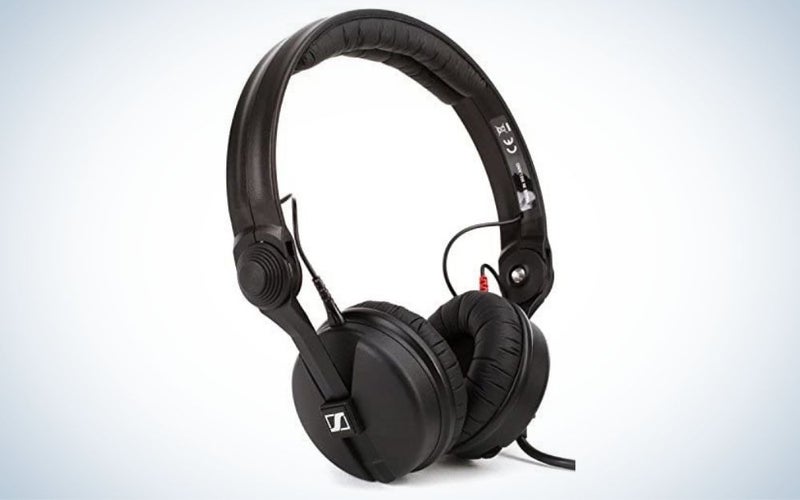
Why it made the cut: Besides being very lightweight, the Sennheiser HD 25 Plus headphones have earned a long-standing reputation amongst DJs for powerful sound that cuts through the noise and replaceable parts that extend your investment.
Specs
- Weight: 0.3 pounds (without cable)
- Driver Units: N/A
- Frequency Response: 16Hz-22kHz
- Accessories: Extra pair of soft ear pads, 39-inch coiled cable (extends to 118 inches), 60-inch straight cable, 1/4-inch plug adapter (threaded), carrying pouch
Pros
- Some of the loudest headphones around, with a maximum SPL of 120 dB
- Trademark split headband for finding a variety of fits
- Lightweight plastic construction is durable and tough, not brittle
- Flip-away ear cups enable one-ear monitoring
Cons
- Tight on-ear fit can pinch ears painfully over time
The Sennheiser HD 25 Plus headphones occupy a special place in the hearts of touring DJs, mobile DJs, and any DJ who put their cans through a ton of use and abuse. This is because the essential parts of the HD 25 Plus headphones are all replaceable and easily available to purchase at retailers. The audio cable that feeds into the ear cup speaker drivers is completely detachable and replaceable; the driver units themselves are replaceable; and so are the headband, headband padding, and ear pads. Yet, regardless of replaceability, the lightweight, mostly plastic construction is built to last; it’s tough and malleable, rather than the brittle plastic of some cheaply made headphones.
Pure loudness counts as another of the HD 25 Plus standout features. With a top SPL of 120 dB, they are some of the loudest DJ headphones you can find and their on-ear, closed-back design blocks outside sounds in loud environments so you can focus on your headphones mix. Unlike most DJ headphones with swiveling earcups, the driver units on the HD 25 Plus detach from the headband for one-ear monitoring. They also have a signature split headband meant to be a little more comfortable on the head over long periods of time.
If you’re looking to save $50, the HD 25 model is the same set of headphones minus the extra set of soft velour earpads, the coiled audio cable, and the carrying pouch.
Best mid-priced: V-Moda Crossfade LP2
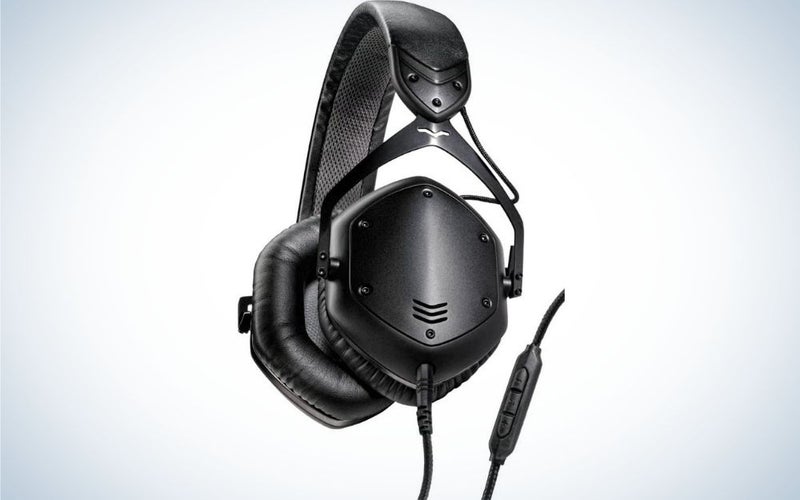
Why it made the cut: The V-Moda Crossfade LP2 delivers a well-rounded mix of extreme durability, huge sound, and good looks for a mid-level price.
Specs
- Weight: 0.57 pounds
- Driver Units: 50mm dual-diaphragm
- Frequency Response: 5Hz-30kHz
- Accessories: 52-inch cable with inline mic and 1-button controller, 78-inch audio-only cable, zippered carrying case with carabiner, 1/4-inch plug adapter, cleaning cloth, removable shield plate kit with extra screws and screwdriver
Pros
- Meticulous build quality
- Generous selection of accessories, including a hardshell case
- Sleek appearance with the option to customize the aluminum ear cup shields
- Very good sound quality with some spiked bass
Cons
- Ear cups do not swivel
- Boost in the low-end doesn’t suit everyone’s needs for music production
V-Moda puts a lot of stock in the materials it uses and, as a result, they are known to be some of the most durable and comfortable headphones available. The Crossfade LP2, for example, has an extremely flexible metal-core headband and Aramid fiber (Kevlar) reinforced cables made for 1 million bends. The removable aluminum shields on the closed-back ear cups can also be customized with the laser engraving or color print of your choice (such as your DJ name/brand)—for an extra cost. A form-fitting “Exoskeleton” zippered carrying case is also excellent for peace of mind when transporting the headphones.
The Crossfade LP2 is not just physically robust. It also has a big, beefy sound for everyday listening and DJ monitoring. The “LP” in the name stands for Live Play and this series of V-Moda headphones has a more bass-hyped sound than its audiophile line. That extra low-end can be appealing to DJs based on personal preference, but is not always ideal for producing music if that’s also a part of your DJ hustle. When listening, the Crossfade LP2 foam ear cushions are meant to fit tight to the head to provide passive noise isolation—good for focusing on the headphone mix in a loud environment. If they’re too tight to be comfortable, you can adjust the headband for relief.
Priced nicely at around $150, the Crossfade LP2 headphones give DJs an attractive mix of sound quality, slick looks, and pristine construction that’s built to last. If you like the V-Moda aesthetic of industry-leading build quality and customizable shield plates but don’t want the LP sound and have deeper pockets, you could spring for the Crossfade M-100 Master, the M-200 studio headphones, the Crossfade 2 Wireless Codex Edition, or the mack-daddy M-200 ANC with active noise cancelling and wireless connectivity.
Best budget: Monoprice Premium Hi-Fi DJ Style Over-the-Ear Headphones
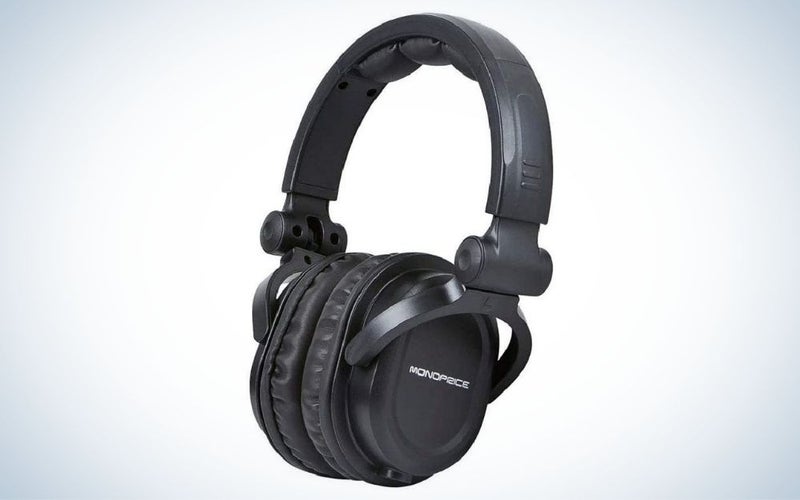
Why it made the cut: For more than 10 years, this unassuming set of Monoprice headphones has been the go-to budget pick for DJs.
Specs
- Weight: 0.99 pounds
- Driver Units: 50mm
- Frequency Response: 20Hz-20kHz
- Accessories: 48-inch cable with inline mic/controller, one 48-inch audio-only cable, 1/4-inch plug adapter
Pros
- Good swiveling and rotating flexibility of the ear cups.
- Detachable audio cable for easy replacement
- Surprisingly long-lasting
- Excellent value for the price
Cons
- No carrying case
- Plastic construction the swiveling and rotating earpieces feel a bit flimsy
The philosophy on choosing headphones for taking on DJ gigs can range from seeking out the most durable set—possibly with replaceable parts—so that they can withstand the rigors of taking them on many road trips, to picking up the best value for the money because if they break they’ll be cheap to replace. The Monoprice Premium Hi-Fi DJ Style Pro Headphones (that’s really the name, unless you want to call them Product #8323) is available for well under $50, which certainly falls under the “cheap replacement” banner. However, I can say from first-hand experience that these headphones can take abuse. I’ve shoved them in a disheveled gear bag and then yanked them out at what feels like 100 DJ sets without them breaking. And the detachable cable is easy to replace with a standard 1/8-inch audio cord. That’s why these Monoprice headphones are our pick if you want to drop the beat without dropping a Benjamin.
The plastic construction of the moving earcup joints doesn’t inspire the most confidence but they do provide the convenient mobility of swiveling the cups 90 degrees and rotating them essentially backward 180 degrees, making one-ear monitoring easy. Neither the comfort level of the over-the-ear cups and the headband nor the sound quality are top-of-the-heap, but I’ve certainly felt and heard worse. With a sensitivity of 100 dB, they do get loud enough to do the job in a noisy club. That is essentially the appeal of these headphones for DJs. They aren’t amazing in any one aspect but sound good enough and are comfortable and flexible enough to function for professional work, while being cheap enough not to sting when they no longer function.
FAQs
Q: Are open-back headphones good for DJing?
Open-back headphones can be used for DJing, although they are not considered ideal for DJing. That’s because open-back headphones let in more external sound than closed-back headphones. Because the main purpose of DJ headphones is to listen to the upcoming song before everyone else hears it so you can mix it in smoothly, you want that upcoming track to be as isolated as possible in the headphones. And because DJs are often in extraordinarily loud clubs and venues, open-back headphones will just make the headphone mix less isolated from outside noise. That’s why none of the headphones in this guide are open-back headphones. If all you have are open-back options, you can still DJ, but headphones made expressly for DJing don’t use the open-back design and we’d only recommend it in a low-level background music type setting.
Q: Can DJ headphones be used for gaming?
Yes, DJ headphones can be used for gaming. Really, almost any headphones can be used for both DJing or gaming but, for both activities, there are certain characteristics that make purpose-built headphones more desirable for one activity or the other. If you use one of the headphones from this guide for gaming, you may or may not have an inline microphone; the ear cups may not be as large as you’d like for long gaming sessions; and they may not offer wireless connectivity. Those things are not needed for gaming but can be nice.
Some things you won’t find in this guide that gamers may want: open-back headphones, active noise cancelation, and 3D audio or spatial audio effects. Open-back headphones are addressed in the previous question. Features like active noise cancelation and processing-based 3D/spatial audio effects are generally not built into headphones aimed at DJs. And those features aren’t a part of this guide because they increase the complexity of the headphones by needing batteries to operate; they create additional fail points within the headphones that working DJs would rather not risk; and those features alter the sound in either subtle or overt ways that DJs who want to hear the pure audio mix do not want.
Q: Can you DJ with wireless headphones?
You can DJ with some wireless headphones but it’s not recommended to DJ with most Bluetooth headphones, because the audio latency between the signal coming from your DJ gear to the audio produced in the wireless headphones is too much to DJ coherently. Traditional Bluetooth latency is about 100ms. If that does not seem like much, you’ll quickly find out when you try to DJ with that much latency that it’s well-nigh impossible to concentrate on what you’re doing with a maddening delay between what your hands are doing and what your ears hear. Bluetooth 5.0 headphones that have the Qualcomm aptX low-latency codec are better at 40ms of latency, but that’s still enough to notice and to distract you from the task at hand. That’s why the only wireless headphones recommended here for DJing are the AIAIAI TMA-2 Studio Wireless+, which use a compact transmitter to send uncompressed audio to the headphones at an acceptably low latency of 16ms—low enough to escape human perception.
The final word on the best DJ headphones
In a pinch, any headphones could be DJ headphones. You could DJ with the junky earbuds that come with a bargain Android phone if you really needed to. Of course, that would be a stressful hassle, which is exactly what you don’t want out of DJ headphones. You want a set of cans that makes the job easier, which means great isolation and clarity so you can blow minds not blow out your eardrums or blow your mix, as well as durability and the most DJ-friendly construction you can get within your budget. The models here are all fine options. The rest is up to you.

